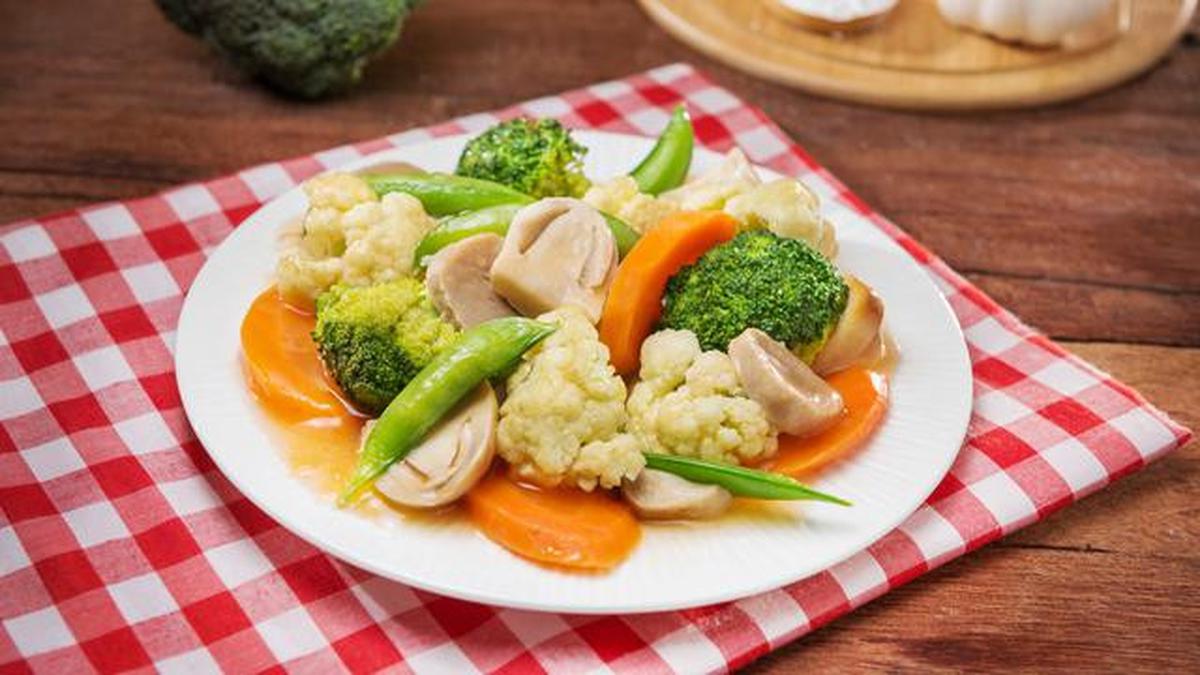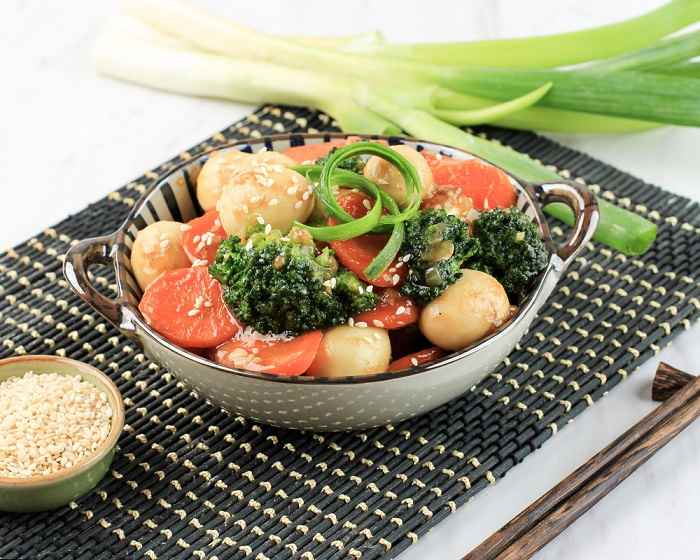
Capcai, also known as Cap Cai or Chap Chai, is a traditional Indonesian stir-fried vegetable dish that showcases the rich and diverse flavors of Indonesian cuisine. Packed with a colorful array of vegetables and savory ingredients, Capcai offers a delightful culinary experience that tantalizes the taste buds. In this article, we’ll explore the origins, ingredients, preparation, and cultural significance of Capcai.

Contents
Origins of Capcai:
Capcai has its roots in Chinese culinary traditions, brought to Indonesia centuries ago by Chinese immigrants. Over time, it has evolved into a beloved Indonesian dish, with each region adding its own unique twist to the recipe. Today, Capcai is enjoyed across the archipelago and is a staple on dining tables during festive occasions and family gatherings.
Ingredients:
The beauty of Capcai lies in its versatility, as it can be made with a wide variety of vegetables and protein sources. Common ingredients include cabbage, carrots, bell peppers, mushrooms, snow peas, baby corn, and bamboo shoots. Additionally, protein such as chicken, shrimp, tofu, or pork can be added to enhance the dish’s flavor and nutritional value.
Preparation:
The preparation of Capcai involves stir-frying the vegetables and protein in a wok with aromatic seasonings and sauces. The vegetables are typically cooked briefly to retain their crispness and vibrant colors, while the protein is cooked until tender and infused with the flavors of the dish. A combination of soy sauce, oyster sauce, garlic, ginger, and chili peppers is commonly used to season Capcai, providing a perfect balance of salty, savory, and spicy flavors.
Cultural Significance:
Capcai holds a special place in Indonesian culture as a symbol of unity and diversity. Its origins in Chinese cuisine reflect Indonesia’s long history of cultural exchange and assimilation, while its adaptation to local ingredients and flavors showcases the country’s culinary creativity. Capcai is often served during celebrations such as Chinese New Year, weddings, and other festive occasions, where it brings people together to share in the joy of good food and fellowship.
Variations:
While the basic concept of Capcai remains the same, there are countless variations of the dish found throughout Indonesia. In some regions, Capcai may include additional ingredients such as quail eggs, fish balls, or bean sprouts. The choice of vegetables and seasonings can also vary depending on personal preferences and regional culinary traditions, making Capcay a truly customizable dish.
Capcai is a flavorful and nutritious dish that embodies the rich culinary heritage of Indonesia. With its colorful array of vegetables, savory protein, and aromatic seasonings, Capcay offers a delightful sensory experience that reflects the diversity and creativity of Indonesian cuisine. Whether enjoyed as a hearty main course or a side dish, Capcay is sure to delight the palate and leave a lasting impression on all who taste it.
Exploring the Pros and Cons of Capcai: A Wholesome Delight in Indonesian Cuisine
Capcai, a traditional Indonesian stir-fried vegetable dish, has earned acclaim for its vibrant flavors, nutritious ingredients, and cultural significance. As with any dish, Capcai comes with its own set of advantages and considerations. In this article, we’ll delve into the pros and cons of Capcai, shedding light on why it’s beloved by many and offering insights into potential considerations when enjoying this delightful dish.

Pros of Capcai:
- Nutrient-Rich Ingredients: One of the primary advantages of Capcay is its use of nutrient-rich vegetables and protein sources. From leafy greens like cabbage and spinach to colorful bell peppers and crunchy bean sprouts, Capcai offers a plethora of vitamins, minerals, and antioxidants essential for overall health and well-being.
- Versatility: Capcai is incredibly versatile, allowing for endless variations based on personal preferences and seasonal availability. You can customize the dish with your favorite vegetables, protein sources, and seasonings, making it adaptable to diverse tastes and culinary traditions.
- Balanced Flavors: Capcay excels in delivering a harmonious balance of flavors, combining savory, sweet, salty, and umami notes in each bite. The combination of soy sauce, oyster sauce, garlic, ginger, and chili peppers creates a complex flavor profile that tantalizes the taste buds without overwhelming them.
- Cultural Significance: Capcay holds cultural significance in Indonesian cuisine, reflecting the country’s multicultural heritage and culinary diversity. Its roots in Chinese cuisine highlight the historical influences and culinary exchanges that have shaped Indonesia’s culinary landscape over the centuries.
Cons of Capcai:
- Preparation Time: While Capcai is relatively simple to prepare, it may require some time and effort to chop and stir-fry the ingredients. For busy individuals or those with limited cooking experience, the preparation process may be perceived as a drawback, especially when compared to quicker meal options.
- Potential Ingredient Costs: Depending on the choice of ingredients and their availability, Capcai can be more expensive to prepare compared to other dishes. Specialty vegetables, protein sources, and imported sauces may contribute to higher ingredient costs, impacting its affordability for some individuals or families.
- Sensitivity to Overcooking: Capcai’s success hinges on achieving the perfect balance of textures, with vegetables cooked until tender-crisp and protein sources cooked just right. Overcooking can result in mushy vegetables and tough protein, detracting from the overall enjoyment of the dish.
- Allergen Sensitivities: Individuals with allergies or dietary restrictions may need to exercise caution when consuming Capcay , especially if it contains common allergens such as soy (in soy sauce), shellfish (in oyster sauce), or gluten (in some seasoning blends). Cross-contamination during preparation is also a concern for those with severe food allergies.
Capcai offers a delightful culinary experience filled with vibrant flavors, wholesome ingredients, and cultural significance. While its versatility and balanced flavors make it a beloved dish among many, considerations such as preparation time, ingredient costs, and allergen sensitivities may influence individuals’ preferences and dietary choices. By weighing the pros and cons of Capcay , one can appreciate its culinary merits while making informed decisions about its inclusion in their diet.
Review: Capcai – A Taste of Indonesia’s Culinary Heritage
Capcai, a beloved dish in Indonesian cuisine, has garnered praise for its vibrant flavors, nutritious ingredients, and cultural significance. This stir-fried vegetable medley offers a delightful fusion of textures and tastes, reflecting the diversity and creativity of Indonesian culinary traditions. In this review, we’ll delve into the sensory experience of Capcay , exploring its flavors, textures, preparation, and cultural relevance.

Flavors and Seasonings:
One of the highlights of Capcay is its rich and complex flavor profile. The dish typically features a medley of vegetables stir-fried with savory seasonings such as soy sauce, oyster sauce, garlic, ginger, and chili peppers. This combination creates a harmonious balance of sweet, salty, savory, and spicy notes that dance on the palate with each mouthful.
Texture and Variety:
Capcai delights not only in flavor but also wdbos in texture, offering a delightful interplay of crunchy, crisp, and tender elements. From crisp-tender vegetables like cabbage and bell peppers to chewy mushrooms and succulent protein sources like shrimp or tofu, Capcay provides a sensory adventure with every bite.
Preparation and Presentation:
The preparation of Capcai is relatively straightforward, involving chopping the vegetables, stir-frying them with the seasonings and protein, and serving the dish hot. While the cooking process may vary slightly depending on personal preferences and regional variations, the essence of Capcai remains consistent: a wholesome and satisfying meal that celebrates the beauty of fresh ingredients and simple cooking techniques.
Cultural Significance:
Beyond its culinary merits, Capcay holds cultural significance in Indonesian society. Its origins in Chinese cuisine reflect Indonesia’s rich history of cultural exchange and assimilation, while its adaptation to local ingredients and flavors symbolizes the country’s culinary creativity and ingenuity. Capcai is often served during festive occasions, family gatherings, and celebrations, where it brings people together to share in the joy of good food and communal feasting.
Overall Impressions:
In summary, Capcai is a culinary gem that showcases the best of Indonesian cuisine. Its vibrant flavors, nutritious ingredients, and cultural resonance make it a beloved dish among locals and visitors alike. Whether enjoyed as a comforting family meal or a special dish for celebrations, Capcai never fails to delight with its exquisite taste and wholesome goodness. For those seeking an authentic taste of Indonesia’s culinary heritage, Capcai is a must-try dish that promises a memorable dining experience.
Read More Article About “Veggie Spring Rolls: A Vegan-Friendly Twist on a Classic Dish“






